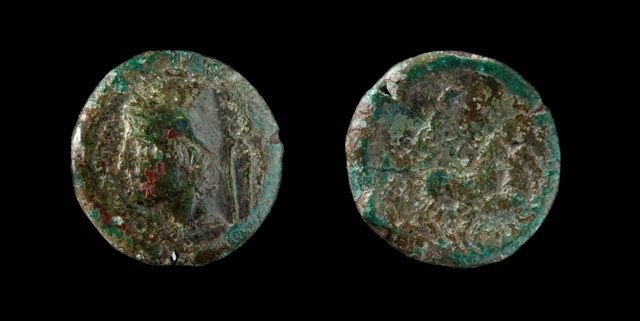Aesernia, Bronze Coin
Dublin Core
Title
Aesernia, Bronze Coin
Subject
Aesernia, Samnii, Italy. AE 21 c. 263 - 240 BCE.
Obverse: Vulcan facing left with laureate pilos (conical felt hat with laurel wreath), a smith's iron tongs behind. Inscription VOLCANOM.
Reverse: Jupiter driving a biga (two-horsed chariot) to the right, hurling fulmen (lightning bolt); above, Victory flying to the right, holding a wreath. Inscription below AISERNINO.
Obverse: Vulcan facing left with laureate pilos (conical felt hat with laurel wreath), a smith's iron tongs behind. Inscription VOLCANOM.
Reverse: Jupiter driving a biga (two-horsed chariot) to the right, hurling fulmen (lightning bolt); above, Victory flying to the right, holding a wreath. Inscription below AISERNINO.
Description
Samnium was located between the silver minting Greek colonies of the south and the colonies of the north that favored bronze. This prime location meant that these middle cities-states did not mint their own coinage until relatively late, around 290 BCE, when Romans took control of the area.
Aesernia (Isernia) was located near the start of the river Vulturnus. It was a town inhabited mostly by Samnites until 263 BCE when it became an official Roman colony. Roman military veterans were moved to the area as a way to keep the local population in check.
Vulcan is an unusual choice for coin illustration and is not represented on many other ancient coins. This area, however, with its large amount of seismic activity, was a fitting place to honor the god of volcanoes. This iconography also suggests that ancient people realized the connection between seismic activity and volcanic eruptions as early as the third century BCE.
Aesernia (Isernia) was located near the start of the river Vulturnus. It was a town inhabited mostly by Samnites until 263 BCE when it became an official Roman colony. Roman military veterans were moved to the area as a way to keep the local population in check.
Vulcan is an unusual choice for coin illustration and is not represented on many other ancient coins. This area, however, with its large amount of seismic activity, was a fitting place to honor the god of volcanoes. This iconography also suggests that ancient people realized the connection between seismic activity and volcanic eruptions as early as the third century BCE.
Source
Gift of James and Aneta McIntyre, Hallie Ford Museum of Art, Salem, OR. 2006.010.026
Date
263 - 240 BCE
Rights
Hallie Ford Museum of Arts
Format
2.140 cm
8.00 gr
8.00 gr
Language
Latin
Type
Coin
Coverage
This item can be viewed on Hallie Ford Museum of Art's website.
Citation
“Aesernia, Bronze Coin,” Hallie Ford Museum of Art Exhibits, accessed December 27, 2025, https://library.willamette.edu/hfma/omeka/items/show/78.
